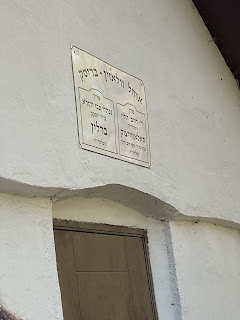Warsaw and Treblinka
I was hoping to upload some little videos here that I’m making for social media but don’t seem to be able to, so if you’d like to see me talking about my days each night seek out the Edgware and Hendon Reform Synagogue Facebook page!
Yesterday was a very long day beginning at 4am at the airport and ending at 9.30pm with a ceremony and testimony recognising 2 families that are righteous among the Nations (rescued a Jew during the Shoah). In between we visited the Jewish cemetery of Warsaw where pre-War some 150,000 Polish Jews were laid to rest. The graves were incredibly diverse and beautiful and packed in between gently swaying trees. It was a fantastic snapshot of Polish life in the 150 ish years before the war. These are just a few snap shots:
My grandmother, born in Łódź didn’t know if her parents died in the Łódź ghetto or the Warsaw ghetto. I realised yesterday it might also have been Treblinka. Like so many others no one will ever know.
From there we stopped briefly at a remnant of the ghetto wall, and then went on to the Jewish Historical Institute to learn about the incredible Ringelblum Archive which was a record of life in the Warsaw Ghetto, and testimonies of the few who had seen what was happening at Treblinka and returned to warn people. These precious documents were stashed in 3 milk churns and buried in hope that their stories would be uncovered and known. So far two churns have been recovered and their contents is harrowing. The institute is a beautiful honouring of these eye witness accounts, preserved at huge risk. Opposite the institute stood the largest synagogue in Warsaw (a Reform Temple) until it was blown up in 1943 to celebrate that Warsaw was ‘Judenfrei’. Free of Jews.
From there we went to meet the Chief Rabbi of Poland in his beautiful synagogue and heard about Jewish life in Poland today.
After dinner we were privileged to witness an evening celebrating the acceptance of a new Righteous among the Nations who hid and helped rescue Max Ostro whose family and rescuers descendents presented their story - a reminder that for every life lost a world was destroyed, and for every life saved, they saved generations of people who would come after them. They closed by singing L’dor V’dor- from generation to generation- the name of our congregation.Today began with stories preserved in the Warsaw ghetto memorial, including the remarkable Janusz Korchak. Only one woman’s story is preserved in those told. This finished at Polin, an amazing museum telling the history of Jewish life in Poland. A life that can only be described as peaks and troughs really! I learnt a huge amount and it’s a beautiful museum.
From there we drove to Treblinka- an extermination camp built purely to kill, and largely this was Jews in this instance- Auschwitz was not only an extermination camp and held a more diverse collection of prisoners. It is a site of pure evil, where memorials exist and prayers are (and we’re) said, both of which are needed, but there is also something deeply unholy there. I was asked to read psalm 23 and I didn’t make it through the words. I choked on
5 You prepare a table before me
in the presence of my enemies.
You anoint my head with oil;
my cup overflows.
6 Surely your goodness and love will follow me
all the days of my life,
The prayers that would have felt unheard in this place were too much to hold. I don’t believe that’s how prayer works, or how I think of God, but the words choked me, and I felt my teenage anger at a God who would allow this. Being there with two wonderful women of faith, Christian and Sikh, to pour over the emotions and the theology with was so moving and helpful. We also discussed the different sense of what cremation means and what holiness means in a place like that and in our traditions.
That conversation carried on after dinner when our group took on some Scriptural reasoning, but before then we rode back listening to survivor, Eve Kugler, sharing her story. You can read it for free here. The privilege of hearing the words from Eve rather than a recording was immense and I’m conscious our children won’t be able to unless they do it soon… and I’m not sure they can hear it yet…
 This is Eve standing at the approach to the main Treblinka memorial.
This is Eve standing at the approach to the main Treblinka memorial.
It has been an exhausting couple of days, and I’ve recorded more of my thoughts in vlogs you can watch on the Edgware and Hendon Reform Synagogue FB pages here and here … I’m not sure I’m making much sense but want to make sure I’m getting things down!
















Excellent
ReplyDelete